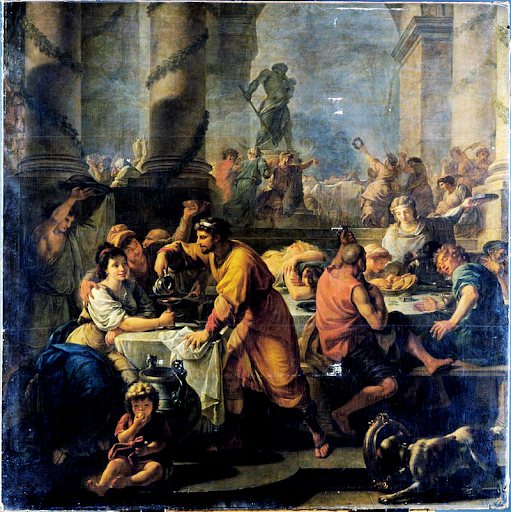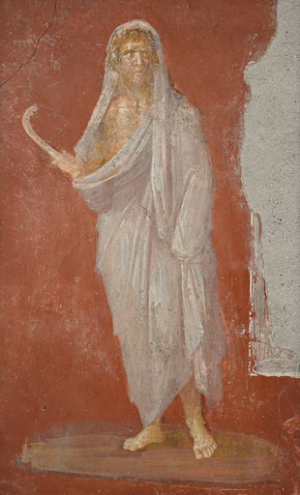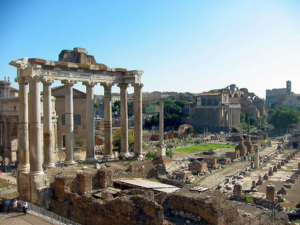Happy Saturnalia

Saturnalia Festival. Photo Source: Antoine Callet
January 12, 2022
It’s the middle of winter, and people walk through the streets caroling. Schools, courts, and businesses are closed for the holiday. The houses the crowd walks past are decorated with candles and wreaths of pine branches. They look forward to holiday feasts later, with friends and family gathering together to celebrate. And, at the end of the festivities, gifts will be exchanged.
This isn’t a scene from Christmas, but instead of Saturnalia, an ancient ancestor of today’s popular winter holiday.
The story of Saturnalia itself, however, begins even earlier than ancient times.
An intriguing pattern throughout all of human history is the common tendency to hold seasonal celebrations. As far back as the records reach, people have always commemorated certain points of the year with parties. One of the most popular celebrations is the midwinter festival. Many cultures across the world celebrate holidays in one form or another in winter and have for a long time.
There are many reasons for this common celebration in the heart of the winter. For one, the dreary months don’t yield much to get excited for, so most are willing to celebrate anything. In ancient times, this was even worse, with people having to endure the cold on top of a limited food supply.
There weren’t many, but winter still yielded some compelling reasons to celebrate other than simple cabin fever. Excess cattle were always killed in the middle of the winter, meaning more meat had to be eaten quickly. Fermentation of alcohol was also usually completed by this time as well, fueling the festivities.
Early astronomers even noticed that after a certain point in the winter, days would start getting longer and warmer. This time of year was celebrated as the return of the sun. Today, we know this point as the winter solstice.
Ancient Rome, a Mediterranean civilization existing between 753 BCE and 476 AD, had its own take on the common midwinter festivities. The Roman version went by the name of “Saturnalia,” and is a major influence on how Christmas is celebrated today.

It’s unclear when Saturnalia was first held. Roman historian Livy suggests the 500s BCE, but some evidence places it far earlier. Either way, by 200 BCE, the celebration was in full swing and would continue in some iteration far beyond the fall of the Roman Empire in 476 AD. The holiday began as a single day, December 17th, but was later extended to December 23rd.
Saturnalia derived its name from Saturn, the Roman god of agriculture. Roman mythology states that Saturn had taught mankind farming techniques and ushered in a golden age of humanity. The Romans had many gods when Saturnalia was first celebrated, making the holiday just one of the many based around the worship of a specific deity.

Saturnalia may not have been the only festival on the Roman calendar, but it was the most popular. There were many elements to the holiday, and some have carried on through to modern Christmas.
Plenty of Saturnalia had unique aspects that differ from Christmas, however. Since it was the seed-sowing season, sacrifices were made to Saturn, and religious events were held that disappeared later in the evolution of Christmas. These Pagan celebrations were halted when the holiday was transformed by Christianity.

Beyond being different religiously, Saturnalia had other elements that are unique from Christmas. For the duration of the holiday, the typically strict Roman social order was overturned.
During Saturnalia, “Kings of Mischief” were appointed. These were usually among the lower members of society and were charged with creating chaos and raucous celebrations. The typically formal, socially distinctive dress of the Romans was abandoned for more casual clothing. Gambling, which was usually illegal, was permitted and even encouraged.
One of the most interesting parts of this flipping of the social order was the role of slaves in the celebrations. For the week of Saturnalia, slaves were allowed to party, drink, play games, and roam free. Roles were reversed, as slave owners were instructed by their slaves to perform chores or serve dinner. This part of Saturnalia has been called “a safety valve designed to release the social pressures built up over the year within Roman society’s strict social conventions.”
Besides allowing slaves to be real people for a week, the Romans most looked forward to Saturnalia for the same reasons that make Christmas exciting today. Many of the popular parts of Christmas were popular in Saturnalia, too.
During Saturnalia, schools and places of work were closed. Virtually all were busy celebrating the holiday. Similar to December 25th, this was done with feasts, games, gift-giving, decorations of candles and pine wreaths, shopping, and partying.

The Roman poet Catullus called Saturnalia “the best of times,” while the author Pliny instead built a sound-proof room to insulate himself from the wild celebrations and write. Regardless, both figures’ reactions speak to how joyous the holiday was.
Saturnalia evolved into Christmas through the Christianization of the Roman Empire. Christianity rose out of the eastern Roman province of Judea in the first century AD, and gradually spread west. From around the 200s AD forward, a process was begun where the Roman Empire officially transitioned from polytheism to monotheism, or the worshiping of multiple gods to just one. This one god became Jesus Christ, who replaced Saturn as the focus of the winter celebration.
In the Christian writings of the Bible, there is no official mention of when Jesus was born. In the 300s AD, however, Pope Julius I chose December 25th as Jesus’ birth date. The choice to place Christmas on the winter solstice (it is now December 21 on today’s calendar) was to associate it with the beloved celebrations already existing in the Roman Empire.
The hope of the Catholic Church was that this move “increased the chances that Christmas would be popularly embraced,” but it “gave up the ability to dictate how it was celebrated.”
With Saturnalia now including Christmas, it wouldn’t be long before the increasingly Christian population of the Roman Empire would drop the Pagan roots of the holiday and embrace midwinter solely as the birthday of Jesus Christ. The Christian church’s move paid off, and Christmas rode the wave of Saturnalia’s popularity to be the dominant winter holiday in Europe.
The carryover of this meshing of Christmas and Saturnalia has made it so the latter’s festivities have become a part of modern Christmas. The similarities between modern Christmas and ancient Saturnalia are clear, with the dinners, gift-giving, lights, and pine decorations.
The story of Christmas is more complex than a linear progression from the Romans, but Saturnalia was certainly one of the main contributing factors that make the holiday into what it is today. So, next time you see lights strung up on houses or enjoy celebrations with family, know that you are doing the same as people who lived over two thousand years ago.
